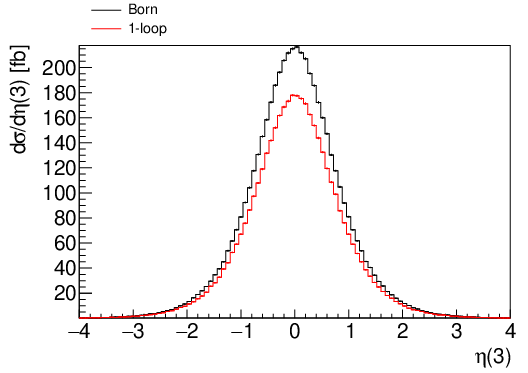Getting Started#
Installing ReneSANCe#
After downloading ReneSANCe, you need to install it on your computer.
The ROOT framework must be available at the stage of compilation.
There are several opportunities for its installation, e.g., from distributive repository,
from the official site or activate it from CernVM-FS repositories located under /cvmfs.
For example, in the case of CERN Scientific Linux 6 (SLC6) with gcc 4.9.* compiler in 64-bit mode
source /cvmfs/sft.cern.ch/lcg/views/ROOT-latest/x86_64-slc6-gcc49-opt/setup.sh
ReneSANCe_pp binary is for hadron-hadron collision mode only.
To compile with support for the hadron collision mode, the LHAPDF
library must be installed on the system.
Other dependencies are bundled into archive with ReneSANCe.
The ReneSANCe event generator uses the CMake build system.
We highly recommend to build ReneSANCe in the separate directory from the source.
To install ReneSANCe run
cmake <path_to_source> -DCMAKE_INSTALL_PREFIX=<inst_prefix> <other options>
cmake --build .
cmake --build . --target install
Using CMake variable CMAKE_INSTALL_PREFIX you can set installation directory.
By default -DCMAKE_INSTALL_PREFIX=<inst_prefix> is set to <path_to_source> directory.
To list all available CMake options with the corresponding descriptions, one can run
cmake -LH <path_to_source>
or use GUI
ccmake .
For example, hadron mode compilation can be disabled using the cmake option:
cmake <path_to_source> -Dhadron_mode=OFF
Setup#
ReneSANCe needs an access to its schema files at run time to work properly.
It searches them relatively to the installation path.
If the generator has been relocated and cannot find schema files, run
source renesance-init.sh
to make it available in the current console or export environment variable RENESANCE_ROOT.
For bash shell:
export RENESANCE_ROOT=<path_to_root_directory_of_ReneSANCe_installation>
Program can be run as
ReneSANCe <option1> <option2> ...
The ReneSANCe event generator has a multilayer configuration system: default parameters are defined in the program, parameters are provided by a user through configuration files (higher priority)
and command line parameters (the highest priority).
Many parameters would be initialized to a default value, which the user can find in the schema files installed in system.
However, some parameters like pid, ecm do not have default value, so the user must provide it manually using a configuration file or command line interface.
The list of command line options:#
- -h, --help#
Print help message and exit.
- -f <FILE>, --file <FILE>#
Set path to index.conf file.
- -o,--out DIR#
Set output directory
- -s,--seed INT#
Set seed
- -p,--pid INT in [101 - 104]#
Set process
- -e,--ecm FLOAT#
Set energy of collider
- --pol1 FLOAT in [-1 - 1]#
Set first beam polarization
- --pol2 FLOAT in [-1 - 1]#
Set second beam polarization
- -D,--define TEXT ...#
Set other settings as list of key:value
By default the program searches for a configuration file that has the name index.conf in the ./input/ directory.
However, it can be provided by the ReneSANCe using the command line parameter -f.
Argument of -f can be directory containing index.conf or full path including arbitrary name of configuration file.
The input file language was built on JSON syntax, so configuration in JSON format is valid. Our input format is less restrictive. The line comments are allowed with # as a separator. Also, opening and closing brackets { } can be omitted. The parameters are initialized using the key:value or key=value syntax. The type of each key is defined in the schema files.
Output#
By default ReneSANCe produces only console output with cross-sections.
To save this output please use console redirection to
file, for example
ReneSANCe -f <folder with input files> | tee file_name.txt
Also in the run directory there are FOAM*.root files with grid created for each branch. They can be used for further calculations with the same input parameters when you want to produce more events on the same grid. The option explore<branch name>=false switches on the search of existing FOAM*.root files with the existing grid.
Using option printROOT=true you can turn on saving of events in ROOT format.
These events are saved to the Results directory by default, but you can change
the pass using option outputDir=/your/desired/path.
Born events are saved into the file named events_LO.root and NLO events are saved
into the file named events_NLO.root. Also the .dat files are generated with
technical information which is used by plot1d and plot2d utilities.
You can produce LHE events files using the option printLHE=true.
Born events are saved into the file named events_LO.lhe and NLO events are
saved into the file named events_NLO.lhe.
Plots#
There is a simple utility to produce plots from ROOT output files. It is compiled and installed by default. Change directory to the folder with ROOT output files and run plot1d to create 1d histograms or plot2d to create 2d histograms. Generally this utility is sample and can be simply modified for your needs.

Example of histogram generated by plot1d.#
